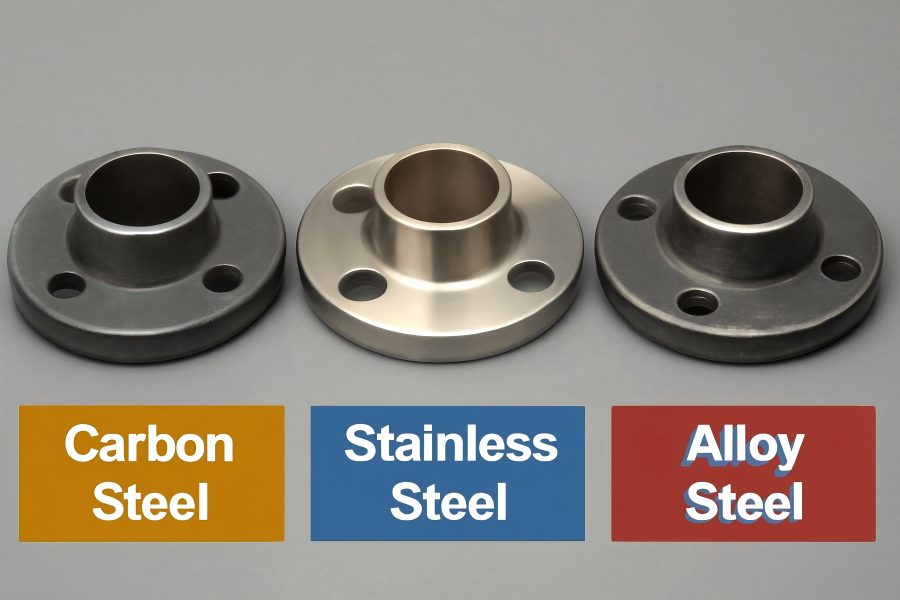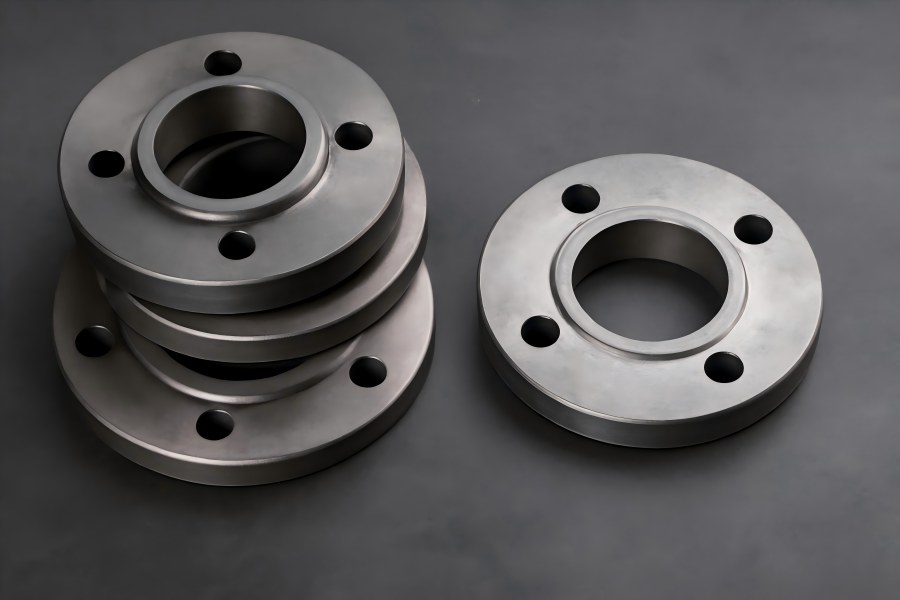Forged steel flanges are crucial for securely joining piping parts, valves, and pumps in sectors like power generation, chemical processing, water treatment, and oil & gas. Understanding their pricing is crucial for businesses to manage procurement costs, as prices depend on factors such as material, size, pressure rating, and customization.
This article explores these factors and offers guidance on estimating flange costs, helping businesses make informed and cost-effective purchasing decisions.
What Are Forged Steel Flanges?
In industrial pipeline systems, forged steel flanges are mechanical parts that join pipes, pumps, valves, and other equipment. They offer superior strength and durability compared to cast flanges due to the forging process, which involves shaping hot steel under pressure.
By aligning the steel’s grain structure, this technique improves its mechanical qualities. Depending on their design and intended use, forged steel flanges come in several varieties. The most prevalent kinds consist of:
- Weld neck flanges: Exceptionally strong and long-lasting, these are designed for high-pressure systems.
- Slip-on Flanges: Low-cost flanges that are welded into position after sliding onto the pipe. It is appropriate for applications requiring minimal pressure.
- Blind flanges: Used to seal pipe ends so that gases or liquids cannot get through.
- Socket Weld Flanges: These offer a more robust and impervious connection for pipes with a lower diameter.
- Threaded Flanges: Flanges that are threaded internally for connection with threaded pipes.
The forging process, typically performed using either open-die or closed-die methods, ensures that forged steel flanges exhibit high mechanical strength, making them ideal for applications where reliability and safety are paramount.
Factors Affecting Forged Steel Flange Prices
Several factors determine the price of forged steel flanges. These factors range from material selection to customizations, manufacturing processes, and order sizes. Below are the key factors influencing flange prices.
Material Grade and Type

The material used for manufacturing forged steel flanges significantly affects their price. The strength, resistance to corrosion, and durability of various materials differ, which affects the cost of manufacture.
- Carbon Steel: The least expensive choice, carbon steel flanges are frequently utilized in low-pressure systems. Compared to other materials, they are less resistant to corrosion, although having considerable mechanical strength.
- Stainless Steel: Because of its exceptional resistance to corrosion, stainless steel flanges are more costly and are therefore best suited for applications requiring chemicals, saltwater, and high-pressure systems.
- Alloy Steel: Applications requiring high temperatures and high pressures are intended for alloy steel flanges. Because of their increased strength and resilience to heat and wear, these flanges are usually more costly.
Table 1: Price Range by Material Type
| Material Type | Price Range (USD) | Applications |
| Carbon Steel | $5 – $150 | Low-pressure, general applications |
| Stainless Steel | $30 – $600 | Corrosive environments, high-pressure systems |
| Alloy Steel | $50 – $700 | High-temperature, high-pressure applications |
Size and Dimensions
The size and dimensions of the flange, including its diameter, thickness, and pressure rating, directly affect its price. Flanges that are thicker and larger cost more to make because they take longer to make and use more material. For example, a standard 6-inch flange will cost more than a 1-inch flange.
Pressure Rating and Class
Flanges are categorized based on their pressure rating, which determines their strength and suitability for various pressure conditions. The most common pressure ratings are:
- 150#: Suitable for low-pressure systems.
- 300#: Used in medium-pressure systems.
- 600#: Designed for high-pressure applications.
The pressure rating affects the material strength and machining requirements, which influences the cost. Higher pressure ratings require more robust flanges, and this usually increases their price.
Manufacturing Process
The cost of the flanges is mostly determined by the forging process. There are two primary forging methods:
Open-Die Forging: This method involves shaping the steel by hammering or pressing it between two open dies. It is typically used for simpler shapes and is less expensive.
Closed-Die Forging: This method involves using a mold that completely encloses the steel, providing greater precision and allowing for more complex shapes. Closed-die forging is more expensive due to the additional tooling and setup costs.
Surface Finish and Coatings
Surface finishes and coatings are often applied to flanges to enhance their durability and corrosion resistance. Common finishes include galvanizing, polishing, and painting. These finishing processes add to the cost of the flange, especially if the flange requires a specialized coating or treatment.
Customization and Design Complexity
Flanges that require custom designs or non-standard dimensions will generally be more expensive. Customizations can include changes in size, drilling additional holes, or special machining operations. Because of extra labor and processing time, the more complicated the design, the higher the production cost.
Quantity Ordered
Bulk purchases often result in lower unit prices. By using economies of scale, manufacturers can lower costs and pass those savings forward to the customer. Smaller orders, on the other hand, tend to have higher unit prices due to the additional setup and labor costs for small production runs.
Supplier Location and Shipping
One important factor influencing pricing is the supplier’s location. Domestic suppliers typically offer lower prices due to reduced shipping costs, whereas international suppliers may offer competitive pricing, but shipping and customs duties can add to the overall cost.
Price Ranges for Forged Steel Flanges
Depending on variables including size, pressure rating, and material type, flange costs can vary greatly. Here is a summary of typical pricing ranges for common materials and sizes.
Table 2: Price Range for Standard Flanges by Size
| Size (Inches) | Price Range (USD) |
| 1″ | $5 – $15 |
| 2″ | $15 – $50 |
| 6″ | $50 – $150 |
| 12″ | $150 – $500 |
Flanges made from carbon steel tend to be the least expensive, while those made from stainless steel or alloy steel are typically more costly. Additionally, flanges with higher pressure ratings, such as 600#, will have higher price tags than lower-rated 150# flanges.
Estimating the Cost of Forged Steel Flanges
To estimate the cost of a forged steel flange, we can consider several factors, including material choice, size, manufacturing process, and additional treatments. Here is a detailed instruction on how to get the approximate cost of a 6-inch carbon steel flange.
Example Calculation:
Let’s calculate the cost of a 6-inch carbon steel flange with a 150# pressure rating. We’ll assume the following costs:
- Material Cost (Carbon Steel): $50
- Manufacturing Process (Open-Die Forging): $40
- Surface Finish (Standard Finish): $20
- Customization (None): $0
- Shipping: $30
The total estimated cost would be:
Total Cost=Material Cost+Manufacturing Cost+Surface Finish+Shipping
Total Cost=50+40+20+30=140USD
Thus, the estimated total cost for this 6-inch carbon steel flange would be $140.
How to Obtain Accurate Price Quotes
To ensure you are getting the best price for your forged steel flanges, it is important to obtain detailed and accurate quotes from multiple suppliers. Here’s how you can go about it:
- Provide Detailed Specifications: Always specify the material, size, pressure rating, finish type, and any custom features you may need.
- Get Multiple estimates: To compare costs and delivery conditions, get estimates from at least three vendors rather than settling for just one.
- Clarify Customization Needs: If you need customized flanges, be sure to detail your requirements to the supplier so they can provide an accurate price.
- Evaluate Quotes Thoroughly: Compare the quotes in terms of total price, lead times, and quality assurance processes. Sometimes, a slightly higher price can result in better quality and reliability.
